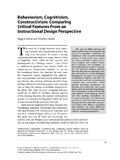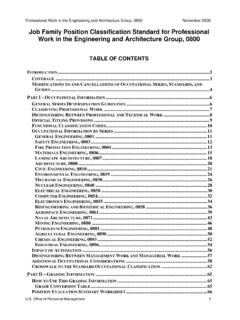Transcription of Behaviorism, Cognitivism, Constructivism: Comparing ...
1 43 PERFORMANCE IMPROVEMENT QUARTERLY,26(2) PP. 43 71 2013 International Society for Performance ImprovementPublished online in Wiley Online Library ( ). DOI: , cognitivism , Constructivism: Comparing Critical Features From an Instructional Design PerspectivePeggy A. Ertmer and Timothy J. NewbyThe need for a bridge between basic learn-ing research and educational practice has long been discussed. To ensure a strong connection between these two areas, Dewey (cited in Reigeluth, 1983) called for the creation and development of a linking science ; Tyler (1978) a middleman position ; and Lynch (1945) foremploying an engineering analogy as an aid for translating theory into practice. In each case, the respective author highlighted the informa-tion and potential contributions of available learn-ing theories, the pressing problems faced by those dealing with practical learning issues, and a general lack of using the former to facilitate solutions for the latter.
2 Th e value of such a bridging function would be its ability to translate relevant aspects of the learning theories into optimal instructional actions. As described by Reigeluth (1983), the fi eld of Instructional Design performs this designers have been charged with translating principles of learning and instruction into specifi cations for instructional materials and activities (Smith & Ragan, 1993, p. 12). To achieve this goal, two sets of skills and knowledge are needed. First, the designer must understand the position of the practitio-ner. In this regard, the following questions would be relevant: What are The way we defi ne learning and what we believe about the way learning occurs has important implications for situations in which we want to facilitate changes in what people know and/or do.
3 Learning theories provide instruct- ional designers with verifi ed instruc-tional strategies and techniques for facilitating learning as well as a founda-tion for intelligent strategy selection. Yet many designers are operating under the constraints of a limited theoretical background. This paper is an attempt to familiarize designers with three rel-evant positions on learning (behavioral, cognitive, and constructivist) which provide structured foundations for planning and conducting instructional design activities. Each learning perspec-tive is discussed in terms of its specifi c interpretation of the learning process and the resulting implications for instructional designers and educational practitioners.
4 The information presented here provides the reader with a compari-son of these three diff erent viewpoints and illustrates how these diff erences might be translated into practical appli-cations in instructional situations. Behaviorism, cognitivism , Constructivism: Comparing Critical Features From an Instructional Design Perspective by Ertmer and Newby is reprinted from Performance Improvement Quarterly, 6(4), 1993, pp. 50 72. doi: DOI: Performance Improvement Quarterlythe situational and contextual constraints of the application? What is the degree of individual diff erences among the learners? What form of solu-tions will or will not be accepted by the learners as well as by those actu-ally teaching the materials? Th e designer must have the ability to diagnose and analyze practical learning problems.
5 Just as a doctor cannot pre-scribe an eff ective remedy without a proper diagnosis, the instructional designer cannot properly recommend an eff ective prescriptive solution without an accurate analysis of the instructional addition to understanding and analyzing the problem, a second core of knowledge and skills is needed to bridge or link application with research that of understanding the potential sources of solutions ( , the theories of human learning). Th rough this understanding, a proper prescriptive solution can be matched with a given diagnosed problem. Th e critical link, therefore, is not between the design of instruction and an autonomous body of knowledge about instructional phenomena, but between instructional design issues and the theories of human this emphasis on learning theory and research?
6 First, learn-ing theories are a source of verifi ed instructional strategies, tactics, and techniques. Knowledge of a variety of such strategies is critical when attempting to select an eff ective prescription for overcoming a given instructional problem. Second, learning theories provide the foundation for intelligent and reasoned strategy selection. Designers must have an adequate repertoire of strategies available, and possess the knowledge of when and why to employ each. Th is knowledge depends on the designer s ability to match the demands of the task with an instructional strategy that helps the learner. Th ird, integration of the selected strategy within the instructional context is of critical importance. Learning theories and research often provide information about relationships among instruc-tional components and the design of instruction, indicating how spe-cifi c techniques/strategies might best fi t within a given context and with specifi c learners (Keller, 1979).
7 Finally, the ultimate role of a theory is to allow for reliable prediction (Richey, 1986). Eff ective solutions to practi-cal instructional problems are often constrained by limited time and resources. It is paramount that those strategies selected and implemented have the highest chance for success. As suggested by Warries (1990), a selection based on strong research is much more reliable than one based on instructional phenomena. Th e task of translating learning theory into practical applications would be greatly simplifi ed if the learning process were relatively simple and straightforward. Unfortunately, this is not the case. Learning is a complex process that has generated numerous interpretations and theo-ries of how it is eff ectively accomplished. Of these many theories, which should receive the attention of the instructional designer?
8 Is it better to choose one theory when designing instruction or to draw ideas from dif-ferent theories? Th is article presents three distinct perspectives of the learning process (behavioral, cognitive, and constructivist) and although each has many unique features, it is our belief that each still describes the Volume 26, Number 2 / 2013 DOI: 45same phenomena (learning). In selecting the theory whose associated instructional strategies off ers the optimal means for achieving desired outcomes, the degree of cognitive processing required of the learner by the specifi c task appears to be a critical factor. Th erefore, as emphasized by Snelbecker (1983), individuals addressing practical learning problems cannot aff ord the luxury of restricting themselves to only one theoretical position.
9 [Th ey] are urged to examine each of the basic science theories which have been developed by psychologists in the study of learning and to select those principles and conceptions which seem to be of value for one s particular educational situation (p. 8).If knowledge of the various learning theories is so important for instructional designers, to what degree are they emphasized and promoted? As reported by Johnson (1992), less than two percent of the courses off ered in university curricula in the general area of edu-cational technology emphasize theory as one of their key concepts. It appears that the real benefi ts of theo-retical knowledge are, at present, not being is article is an attempt to fi ll in some of the gaps that may exist in our knowledge of modern learning theories.
10 Th e main intent is to provide designers with some familiarity with three relevant positions on learning (behavioral, cognitive, and constructivist) which should provide a more structured foundation for planning and conducting instructional design activities. Th e idea is that if we understand some of the deep principles of the theories of learning, we can extrapolate to the particulars as needed. As Bruner (1971) states, You don t need to encounter everything in nature in order to know nature (p. 18). A basic understanding of the learning theories can provide you with a canny strategy whereby you could know a great deal about a lot of things while keeping very little in mind (p. 18).It is expected that after reading this article, instructional designers and educational practitioners should be better informed consumers of the strategies suggested by each viewpoint.






